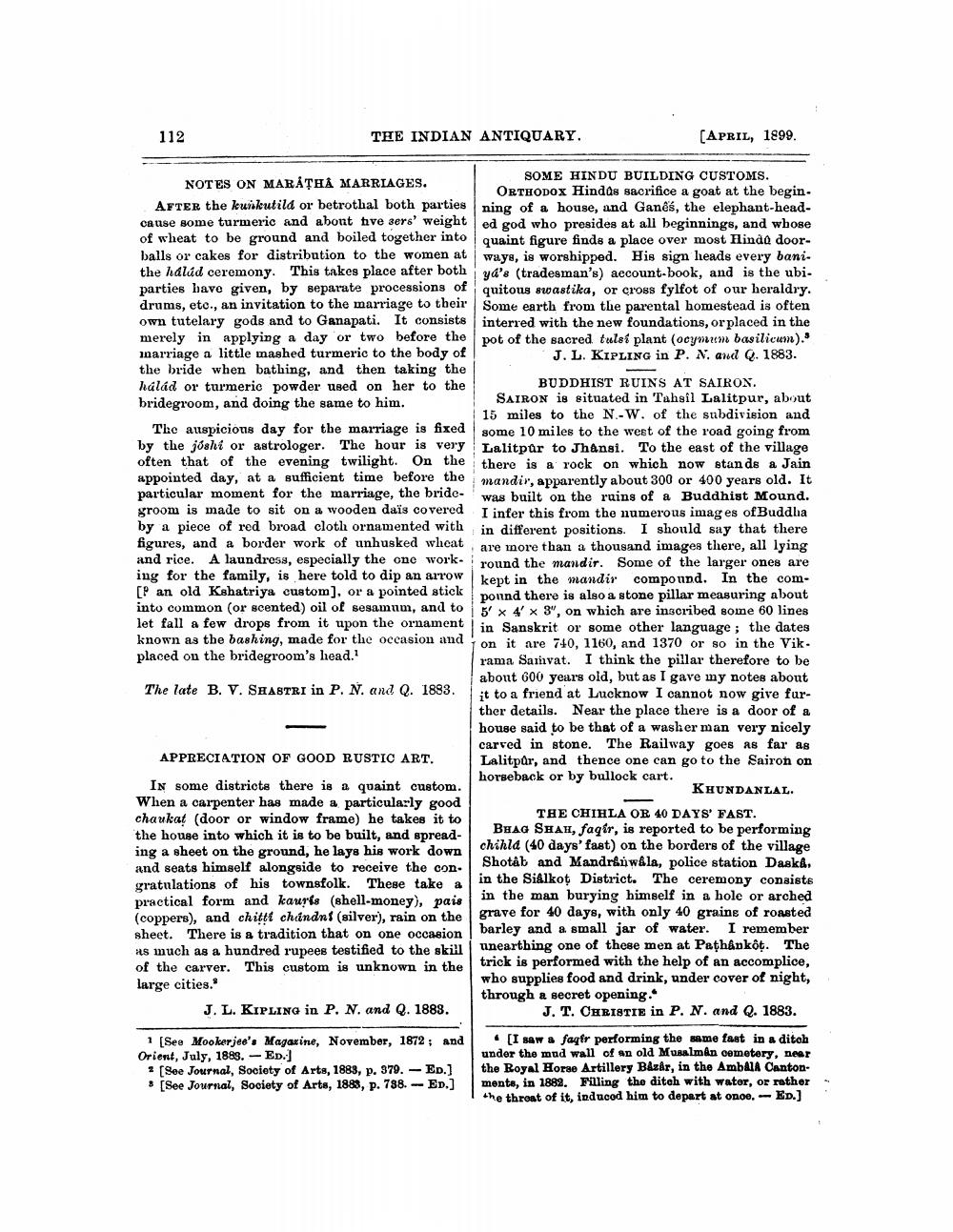________________
112
THE INDIAN ANTIQUARY.
(APRIL, 1899.
SOME HINDU BUILDING CUSTOMS. NOTES ON MARÅTHÅ MARRIAGES.
ORTHODOX Hindus sacrifice a goat at the begin. AFTER the lunkutild or betrothal both parties ning of a house, and Ganes, the elephant-headcause some turmeric and about five sers' weighted god who presides at all beginnings, and whose of wheat to be ground and boiled together into quaint figure finds a place over most Hindo doorballs or cakes for distribution to the women at ways, is worshipped. His sign heads every bani. the halád ceremony. This takes place after both ya's (tradesman's) account-book, and is the ubi. parties have given, by separate processions of quitous swastika, or cross fylfot of our heraldry.
ims, etc., an invitation to the marriage to their Some earth from the parental homestead is often own tutelary gods and to Ganapati. It consists
interred with the new foundations, or placed in the merely in applying a day or two before the
pot of the sacred tulsi plant (ocynum basilicum). inarriage a little mashed turmeric to the body of
J.L. KIPLING in P. N. and Q. 1883. the bride when bathing, and then taking the halád or turmeric powder used on her to the
BUDDHIST RUINS AT SAIROX. bridegroom, and doing the same to him.
I SAIRON is situated in Tahsil Lalitpur, about
15 miles to the N.-W. of the subdivision and The auspicions day for the marriage is fixed
some 10 miles to the weet of the road going from by the joshi or astrologer. The hour is very
Lalitpur to Jhansi. To the east of the village often that of the evening twilight. On the there is a rock on which now stands a Jain appointed day, at a sufficient time before the mandir, apparently about 300 or 400 years old. It particular moment for the marriage, the bride was built on the ruins of a Buddhist Mound. sroom is made to sit on a wooden dais covered I infer this from the numerous images of Buddha by a piece of red broad cloth ornamented with in different positions. I should say that there figures, and a border work of unhusked wheat are more than a thousand images there, all lying and rice. A laundross, especially the one work. round the mandir. Some of the larger ones are ing for the family, is here told to dip an arrow
kept in the mandir compound. In the com[P an old Kshatriya custom), or a pointed stick
pound there is also a stone pillar measuring about into common (or scented) oil of sesamum, and to 5 X 4' x 3", on which are inscribed some 60 lines let tall a few drops from it upon the ornament in Sanskrit or some other language; the dates known as the bashing, made for the occasion and
sion and 1 on it are 740, 1160, and 1370 or so in the Vik. placed on the bridegroom's head.
rama Samvat. I think the pillar therefore to be
about 600 years old, but as I gave my notes about The late B. V. SHASTRI in P. N. and Q. 1883.
it to a friend at Lucknow I cannot now give further details. Near the place there is a door of a house said to be that of a washer man very nicely
carved in stone. The Railway goes as far as APPRECIATION OF GOOD RUSTIC ART. Lalitpar, and thence one can go to the Sairon on
horseback or by bullock cart. In some districts there is a quaint custom.
KHUNDANLAL. When a carpenter has made a particularly good chaukat (door or window frame) he takes it to
THE CHIHLA OR 40 DAYS FAST. the house into which it is to be built, and spread
BHAG SHAH, faqfr, is reported to be performing ing a sheet on the ground, he lays his work down
chihla (40 days' fast) on the borders of the village and seats himself alongside to receive the con.
Shotab and Mandriwêla, police station Daska. gratulations of his townsfolk. These take a
in the Sialkot District. The ceremony consists practical form and kauris (shell-money), pais
in the man burying himself in a hole or arched (coppers), and chitti chándns (silver), rain on the
grave for 40 days, with only 40 grains of roasted sheet. There is a tradition that on one occasion
barley and a small jar of water. I remember as much as a hundred rupees testified to the skill
unearthing one of these men at Path&nkot. The of the carver. This custom is unknown in the
trick is performed with the help of an accomplice,
who supplies food and drink, under cover of night, large cities."
through a secret opening." J. L. KIPLING in P. N. and Q. 1883.
J. T. CHRISTIE in P. N. and Q. 1883.
1 [See Mookerjee's Magazine, November, 1872; and Orient, July, 1889. -ED.)
(Soe Journal, Society of Arts, 1883, p. 379. - ED.) [See Journal, Society of Arts, 1888, p. 788. -- ED.)
• I saw a fagfr performing the same fast in a ditch under the mud wall of an old Musalman cemetery, near the Royal Horae Artillery Bazár, in the Ambala Cantonmonts, in 1882. Filling the ditch with water, or rather the throat of it, inducod him to depart at once. ED.)




